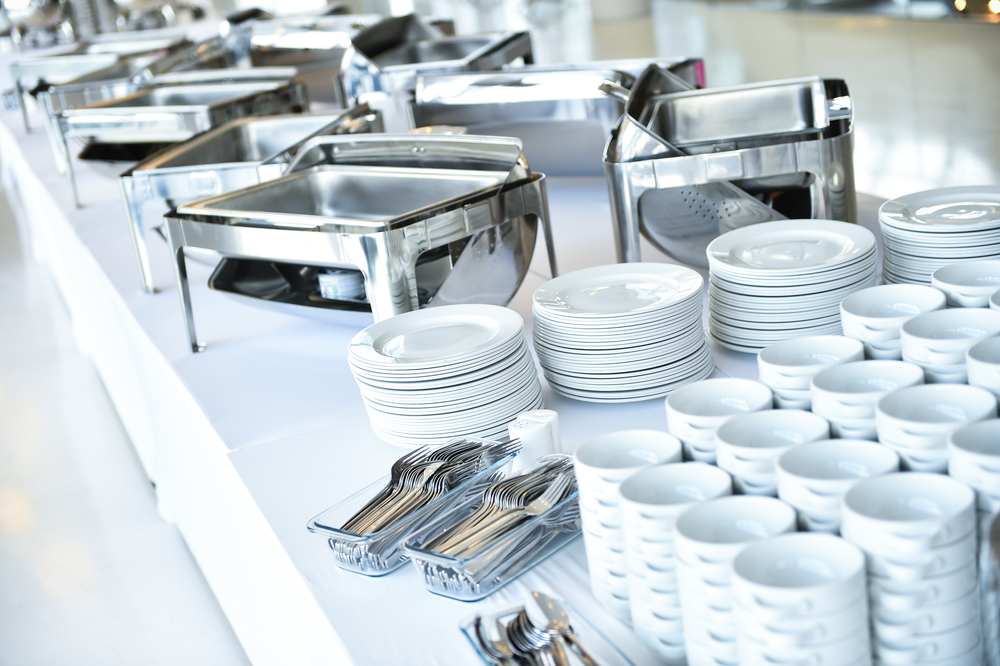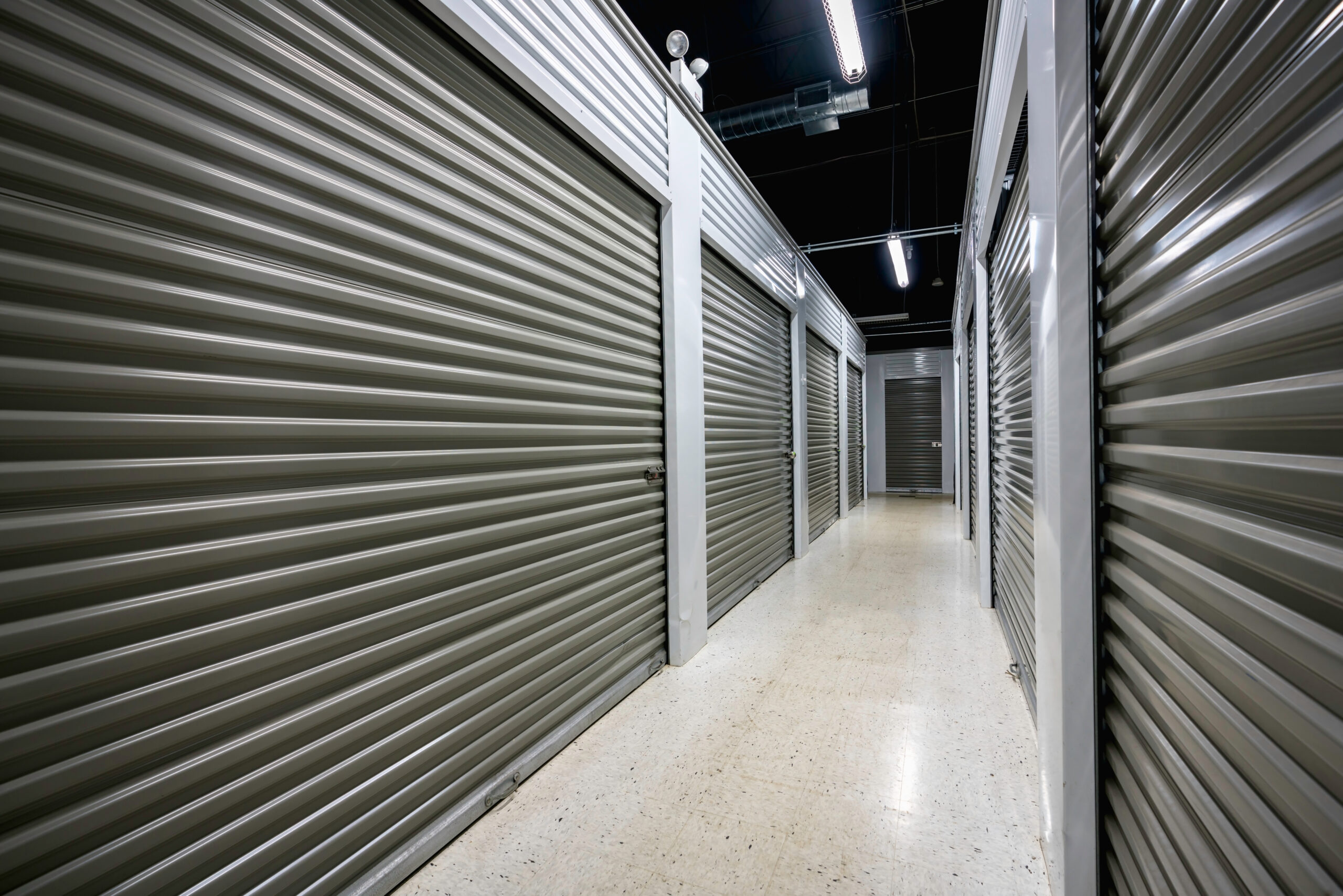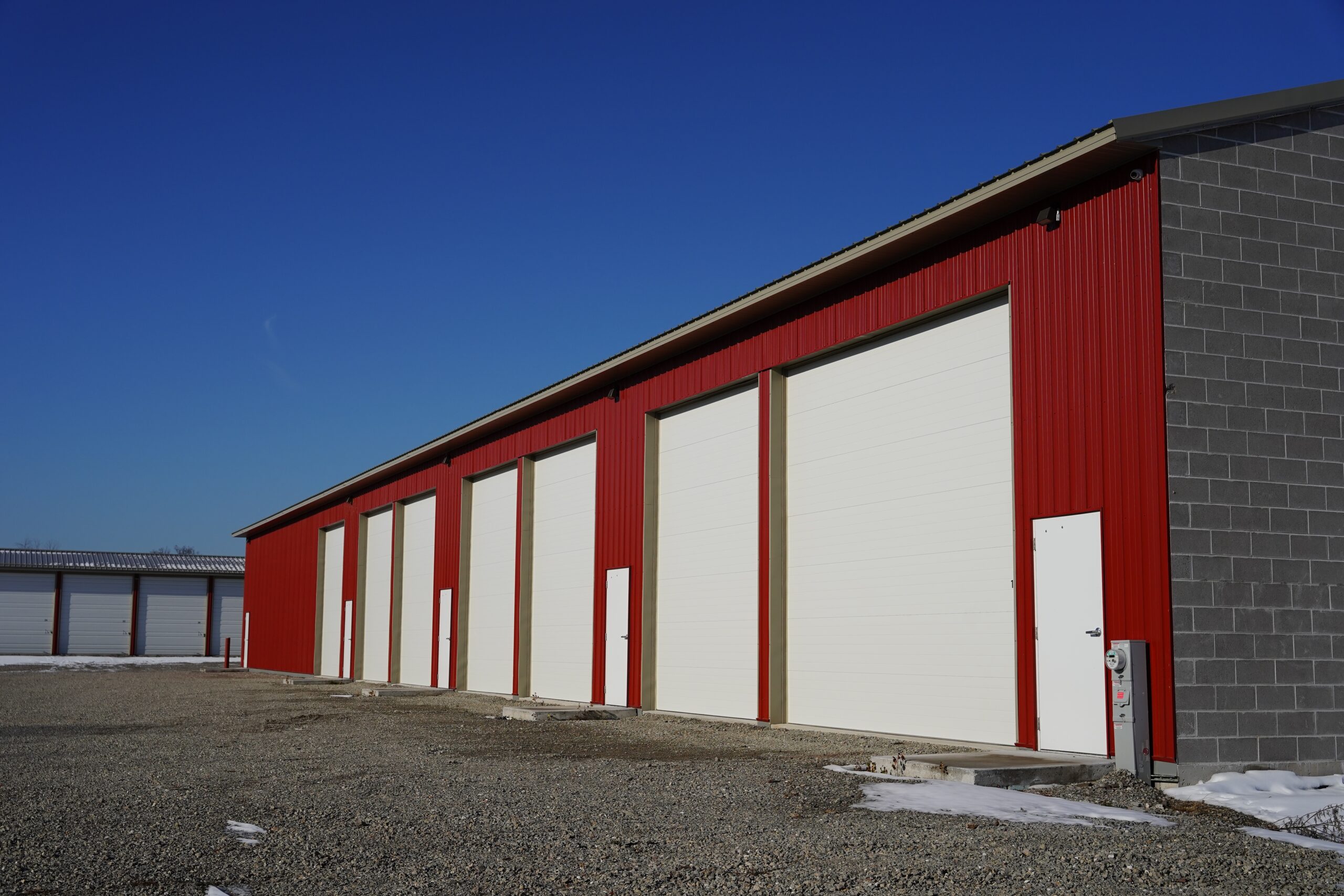Key Takeaways:
- A well-organized catering setup saves you time, money, and stress.
Self-storage can be a game-changer for managing seasonal, bulky, or infrequently used business equipment.
Never store perishable food items in a storage unit — unless you like uninvited critters!
Catering is an art that blends creativity, efficiency, and impeccable organization. From managing perishable ingredients to storing large-scale kitchen equipment, a well-organized catering supply storage system can make or break an event. Proper storage ensures that supplies remain fresh, equipment is easily accessible, and operations run smoothly without unnecessary delays or mishaps.
Whether you run a small catering business, a food truck, or a large-scale operation, maintaining an organized and efficient business storage system is crucial for success. Without a structured approach, supplies can become misplaced, food safety can be compromised, and time can be wasted searching for essential tools and ingredients. Additionally, a streamlined system can significantly impact workflow efficiency, helping caterers meet tight deadlines and deliver seamless events.
In this ultimate guide, we’ll cover everything you need to know about catering supply storage and organization, including best practices, essential storage solutions, and tips for maximizing efficiency. By implementing the right strategies, you can improve productivity, reduce waste, and enhance the overall success of your banquette business.
Catering Equipment Checklist
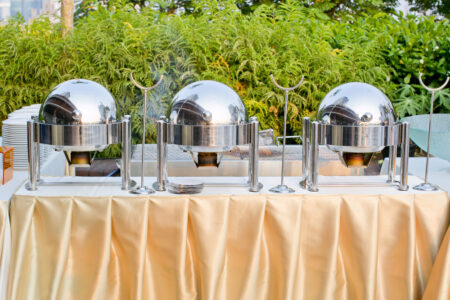
Having the right catering equipment is essential for smooth operations. Here is a checklist of key items to ensure your business is fully equipped:
Kitchen Equipment:
- Commercial ovens and stoves
- Food processors and mixers
- Refrigerators and freezers
- Cutting boards and knives
- Storage containers and shelving units
- Prep tables and counters
Serving Equipment:
- Chafing dishes and food warmers
- Serving trays and platters
- Beverage dispensers and coffee urns
- Ice bins and coolers
- Utensils for serving and buffet stations
Transport & Storage Solutions:
- Insulated food carriers
- Rolling racks and carts
- Stackable storage bins
- Labeling system for organized tracking
- Shelving for dry and cold storage
Tableware & Linens:
- Tablecloths, napkins, and chair covers
- Silverware, glassware (especially delicate items such as shot glasses), and dinnerware
- Centerpieces and event decor
Cleaning & Sanitation Supplies:
- Dishwashing stations and sanitizing solutions
- Trash bins and recycling containers
- Disposable gloves and aprons
Having this checklist will help you be sure that all critical catering supplies are accounted for, minimizing last-minute issues and enhancing operational efficiency.
Why Proper Storage & Organization Matter
A well-structured catering storage and organization system is the backbone of a smooth and efficient operation. By implementing proper storage strategies, caterers can not only streamline their workflow but also enhance food safety, reduce costs, and minimize stress. Here are some key benefits of maintaining an organized catering supply system:
- Efficiency – Quick and easy access to supplies saves time and prevents last-minute scrambling.
Food Safety & Compliance – Proper storage helps maintain food quality and meet health code requirements.
Cost Savings – Reducing waste and preventing duplicate purchases saves money in the long run.
Stress Reduction – A well-organized system makes catering events smoother and reduces operational stress.
Extended Equipment Lifespan – Proper storage extends the life of kitchen tools, appliances, and supplies.
Pro Tip: For smaller businesses, including catering companies, a storage unit provides a secure and organized space to keep extra equipment, bulk supplies, and seasonal décor without overcrowding your kitchen or workspace. With flexible rental options, climate-controlled units, and enhanced security, a storage unit can help ensure your business stays efficient, clutter-free, and ready for any event!
Assessing Your Storage Needs
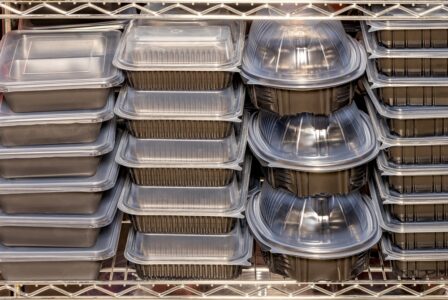
Before implementing a storage system, take the time to thoroughly assess your specific needs to ensure efficiency and long-term organization. Understanding what you have, how frequently you use it, and where it should be stored will help create a seamless workflow. Consider factors such as inventory levels, space constraints, accessibility, and specialized storage requirements to develop a system tailored to your catering business.
- Inventory Check – Take stock of all catering supplies, from food and drink items (including alcohol such as wine or whiskey) to cookware and linens.
Frequency of Use – Categorize items based on how often they are used.
Available Space – Measure storage areas to determine space constraints and optimization opportunities.
Special Requirements – Consider temperature-sensitive items, fragile equipment, and bulky supplies.
Pro Tip: Many businesses use self-storage to save space and help businesses run efficiently!
Essential Catering Storage Solutions
To keep your catering business running smoothly, invest in high-quality storage solutions that enhance efficiency, protect supplies, and streamline operations. Proper storage ensures quick access to essential items, minimizes damage or spoilage, and maximizes space utilization. Here are some must-have options to consider for different aspects of your catering storage needs:
Dry Storage Solutions
Dry storage areas hold non-perishable items like canned goods, dry ingredients, utensils, and tableware. Keeping these areas well-organized ensures quick access to essential items and reduces unnecessary waste. To maintain an efficient dry storage system, consider factors such as proper ventilation, pest prevention, and space optimization. Here are some ideal solutions to help streamline your dry storage setup:
- Shelving Units – Sturdy, adjustable shelves maximize space and improve accessibility.
Stackable Bins – Use labeled bins to store smaller items such as napkins, cutlery, and condiments.
Hanging Racks – Utilize wall-mounted racks for lightweight supplies.
Labeling System – Clearly label shelves and containers for easy identification.
Cold Storage Solutions
Perishable catering supplies require proper refrigeration to maintain freshness and prevent spoilage. Temperature control is crucial to preserving food quality and ensuring compliance with health regulations. Proper storage methods also help minimize waste and extend the shelf life of ingredients. Investing in high-quality refrigeration units, using food-grade storage containers, and regularly monitoring temperature settings can significantly improve food safety and efficiency in catering operations.
- Walk-In Coolers & Freezers – Essential for large-scale catering operations.
Refrigerated Prep Tables – Provide quick access to perishable ingredients during food preparation.
Storage Containers – Use airtight, food-grade containers to prevent cross-contamination.
FIFO System – Implement the “First In, First Out” system to rotate stock efficiently.
Pro Tip: Avoid storing extra food supplies in your business storage unit — not only do storage units not provide adequate temperature control for food, but storing food in your storage unit creates an insurance liability and high-risk invitation for pests to move into your unit.
Equipment & Utensil Storage
Proper storage of kitchen tools and appliances extends their lifespan, ensures easy access, and improves overall kitchen efficiency. A well-organized system prevents damage, reduces clutter, and allows chefs and staff to find what they need quickly. Storing tools properly also helps maintain hygiene standards and minimizes the risk of cross-contamination in a busy catering environment. Investing in high-quality storage solutions, such as dedicated shelving, protective cases, and hanging racks, can significantly impact the workflow of a catering business.
- Pegboards & Hooks – Hang pots, pans, and frequently used utensils.
Drawer Organizers – Keep small tools like knives, peelers, and thermometers organized.
Rolling Carts – Mobile carts allow for easy transport of utensils and appliances between prep areas.
Protective Cases – Store delicate items, such as glassware and chafing dishes, in padded cases.
Linens & Tableware Storage
Catering events require well-maintained linens, table settings, and decor to create a polished and professional atmosphere. Proper storage not only keeps these items in pristine condition but also streamlines setup and breakdown processes. Without an organized approach, linens can become wrinkled, tableware may be misplaced, and decor could sustain damage. Use these strategies to keep everything well-organized and easily accessible:
- Shelving & Cubbies – Neatly store folded tablecloths, napkins, and chair covers.
Hanging Racks – Prevent wrinkles by hanging fabric items.
Stackable Racks for Plates – Protect delicate tableware and ensure easy access.
Storage Bags for Silverware – Prevent tarnishing with air-tight storage.
Maximizing Space & Organization Efficiency
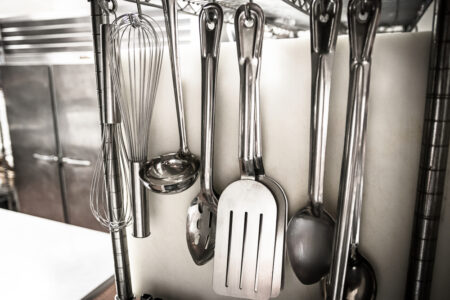
Declutter Regularly
A cluttered storage area makes it difficult to find supplies, slows down operations, and increases the likelihood of misplaced or expired items. Regular inventory checks should be scheduled to not only remove expired items and unused equipment but also to reorganize and optimize storage space. Implementing a structured audit process, such as a quarterly or monthly deep clean and reassessment, can improve efficiency and help maintain a well-organized workspace.
Implement a Labeling System
Clearly label shelves, bins, and containers using:
- Color-coded labels for different categories (e.g., food, equipment, decor).
Waterproof labels for refrigerated storage.
Digital inventory tracking for real-time updates.
Optimize Vertical Space
Make use of high ceilings with:
- Stackable shelves and containers.
Wall-mounted racks for lightweight items.
Hanging storage for cooking utensils.
Use Clear Storage Bins
Transparent bins allow for easy identification of contents, reducing the time spent searching for items and enhancing overall efficiency in a catering operation. By enabling quick visual access, these bins help staff locate ingredients, tools, or supplies without unnecessary delays. Additionally, they contribute to inventory management by making it easier to track stock levels at a glance, reducing the likelihood of over-purchasing or running out of essential items. Using transparent bins also promotes better hygiene, as it is easier to spot contamination or spills, ensuring that food safety standards are consistently met.
Invest in Mobile Storage Solutions
Rolling racks and carts improve workflow efficiency, making transportation of supplies seamless during events. They allow catering staff to move heavy or bulky items with ease, reducing physical strain and saving valuable time. Additionally, mobile storage solutions help maintain organization during busy service periods, ensuring that necessary tools and ingredients are always within reach. Investing in high-quality, durable carts with locking wheels can provide both stability and convenience during transport.
Pro Tip: If storage space is limited, consider renting a nearby storage unit to keep infrequently used equipment and bulk supplies organized, accessible, and safe, without cluttering your main workspace. This can be especially useful for seasonal catering items or large-scale event equipment.
Food Safety & Compliance in Storage
Health and safety regulations are critical in catering storage to prevent contamination, maintain food quality, and comply with industry standards. Proper storage practices not only protect customers from foodborne illnesses but also help businesses avoid fines and legal complications. A well-organized storage system ensures that food is handled safely, temperatures are maintained, and inventory is rotated correctly to prevent spoilage.
Storage tip: Self-storage units are great for storing tables, chairs, and catering equipment, but not for food. Even storage of non-perishables food is usually not allowed at most self-storage facilities.
Digital Tools for Storage & Inventory Management
Incorporate technology to streamline inventory management and improve efficiency in tracking supplies. By using digital tools, catering businesses can reduce human error, prevent stock shortages, and enhance overall organization. Advanced inventory systems allow for real-time tracking, automated alerts for low stock, and seamless integration with ordering platforms, ensuring that the right supplies are always on hand when needed.
- Inventory Tracking Software – Apps like MarketMan, BlueCart, or PeachWorks help track stock levels in real-time.
Barcode Scanners – Speed up inventory updates by scanning product barcodes.
Cloud-Based Systems – Enable remote access to inventory data from any location.
Training Staff on Storage Best Practices
An organized storage system only works if the entire team follows best practices and maintains consistency in their approach. Clear communication, proper training, and accountability are essential to ensuring that everyone understands the importance of storage efficiency. Without team cooperation, even the best-designed storage solutions can become ineffective, leading to misplaced items, wasted time, and potential safety hazards.
- Train staff on proper storage procedures.
Assign roles for inventory management.
Conduct regular audits to ensure compliance.
The Key to an Efficient Catering Storage System
Catering storage and organization go beyond just stacking supplies in a closet—it’s about creating a structured system that enhances efficiency, safety, and profitability. By implementing smart storage solutions, utilizing digital tools, and maintaining proper safety standards, catering businesses can streamline operations and deliver seamless event experiences.
An organized catering business starts with efficient storage solutions. Whether you need extra space for seasonal equipment, bulk supplies, or event essentials, Storage.com makes it easy to find the perfect storage unit near you. With flexible options, secure facilities, and convenient locations, you can keep your catering operation running smoothly without cluttering your workspace.
Don’t let limited space hold you back — find a storage unit today and take your catering business to the next level!
Frequently Asked Questions (FAQ)
1. What is the best way to organize catering supplies for easy access?
The best way to organize catering supplies is by categorizing items based on frequency of use, type, and storage needs. Utilize clear bins, labeling systems, and shelving units to keep supplies visible and accessible. Implementing a digital inventory system can also help track stock levels efficiently.
2. How can I maximize space in a small catering storage area?
To maximize space, use vertical storage solutions such as stackable shelves and wall-mounted racks. Consider rolling carts for mobility, collapsible storage for seasonal items, and renting an off-site storage unit for less frequently used equipment.
3. What are the best practices for storing perishable catering supplies?
Perishable items should be stored at appropriate temperatures in walk-in coolers, refrigerators, or freezers. Use airtight containers, follow the First In, First Out (FIFO) method to rotate stock, and regularly monitor temperature settings to maintain food safety standards.
4. How often should I conduct an inventory check for catering supplies?
Regular inventory checks should be conducted weekly or monthly, depending on your catering volume. A structured audit process helps reduce waste, prevent overstocking, and ensure essential supplies are always available.
5. What is the best way to transport catering supplies for an event?
Use insulated food carriers for temperature-sensitive items, secure fragile supplies in padded cases, and organize transport vehicles based on order of use. Rolling carts and bungee cords can help stabilize equipment during transit.
6. How can I prevent cross-contamination in storage areas?
Store raw and cooked foods separately, use color-coded containers for allergen-sensitive ingredients and maintain strict cleaning protocols. Designate specific storage zones for different types of food and supplies to ensure safety.
7. What digital tools can help with catering inventory management?
Apps like MarketMan, BlueCart, or PeachWorks provide real-time inventory tracking, automated alerts for low stock, and integration with ordering systems. Barcode scanners can also speed up stock management and reduce errors.
8. What are the benefits of using mobile storage solutions?
Mobile storage solutions such as rolling racks and carts improve workflow by making it easier to transport supplies between prep areas and event locations. They also help optimize space and minimize lifting-related injuries for staff.
9. How do I keep my catering linens and tableware in top condition?
Store linens in breathable fabric bags or hanging racks to prevent wrinkles, and keep tableware in stackable racks with soft dividers to avoid chips or cracks. Regularly inspect and clean these items to maintain their quality.10. When should I consider renting an external storage unit for my catering business?
If your kitchen or storage space is too limited to accommodate bulk supplies, seasonal equipment, or infrequently used items, renting a storage unit can be a cost-effective solution. This ensures your workspace remains uncluttered while keeping necessary items accessible.
